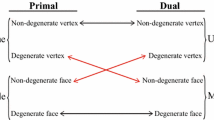Abstract
A novel approach to metabolic network analysis using a Nash Equilibrium (NE) formulation is proposed in which enzymes are considered players in a multi-player game. Each player has its own payoff function with the objective of minimizing the Gibbs free energy associated with the biochemical reaction(s) it catalyzes subject to elemental mass balances while the network objective is to find the best solution to the sum of the player payoff functions. Consequently, any NE solution may not be best solution for all players. Key advantages of the NE approach include the ability to account for (1) aqueous electrolyte behavior, (2) the consumption/production of co-factors, and (3) charge balancing. However, the proposed Nash equilibrium formulation results in a set of nonlinear programming sub-problems that are more demanding to solve than conventional flux balance analysis (FBA) formulations which rely on linear programming. A direct substitution solution methodology for pathways with feedback is described. The Krebs cycle is used to demonstrate the efficacy of the NE approach while comparisons with both FBA and experimental data are used to show that it represents a paradigm shift in metabolic network analysis.


Similar content being viewed by others
References
Varma, A., Palsson, B.O.: Metabolic flux balancing: basic concepts, scientific and practical use. Nat. Biotechnol. 12, 994–998 (1994)
Kauffman, K.J., Prakash, P., Edwards, J.S.: Advances in flux balance analysis. Curr. Opin. Biotechnol. 14, 491–496 (2003)
Holzhutter, H.G.: The principles of flux minimization and its application to estimate stationary fluxes in metabolic networks. Eur. J. Biochem. 271, 2905–2922 (2004)
Julius, A.A., Imielinski, M., Pappas, G.J.: Metabolic networks analysis using convex optimization. In: Proceedings of the 47th IEEE Conference on Decision and Control, 762 (2008)
Smallbone, K., Simeonidis, E.: Flux balance analysis: a geometric perspective. J. Theor. Biol. 258, 311–315 (2009)
Murabito, E., Simeonidis, E., Smallbone, K., Swinton, J.: Capturing the essence of a metabolic network: a flux balance analysis approach. J. Theor Biol. 260(3), 445–452 (2009)
Lee, S., Phalakornkule, C., Domach, M.M., Grossmann, I.E.: Recursive MILP model for finding all the alternate optima in LP models for metabolic networks. Comput. Chem. Eng. 24, 711–716 (2000)
Henry, C.S., Broadbelt, L.J., Hatzimanikatis, V.: Thermodynamic metabolic flux analysis. Biophys. J. 92, 1792–1805 (2007)
Mahadevan, R., Edwards, J.S., Doyle, F.J.: Dynamic flux balance analysis in diauxic growth in Escherichia coli. Biophys. J. 83, 1331–1340 (2002)
Patane’, A., Santoro, A., Costanza, J., Nicosia, G.: Pareto optimal design for synthetic biology. IEEE Trans. Biomed. Circuits Syst. 9(4), 555–571 (2015)
Angione, C., Costanza, J., Carapezza, G., Lio’, P., Nicosia, G.: Multi-target analysis and design of mitochondrial metabolism. PLoS ONE 9, 1–22 (2015)
Varma, A., Palsson, B.O.: Metabolic capabilities of Escherichia coli: synthesis of biosynthetic precursors and co-factors. J. Theor. Biol. 165, 477–502 (1993)
von Heusinger, A.: Numerical methods for the solution of generalized Nash equilibrium problems. Ph.D. Thesis, University of Wurzburg (2009)
Yuan, Y.: A trust region algorithm for Nash equilibrium problems. Math. Prog. 7, 1–14 (2011)
Fischer, A., Herrich, M., Shonefeld, K.: Generalized Nash equilibrium problems—recent advances and challenges. Pesqui. Oper. 34(3), 521–558 (2014)
Lucia, A., DiMaggio, P.A.: A Nash equilibrium approach to metabolic network analysis. In: Pardalos, P.M. et al. (ed.) MOD 2016, LNCS 10122, 1–14 (2016)
Alberty, R.A.: Thermodynamics of Biochemical Reactions. Wiley, Hoboken (2003)
Elliott, J.R., Lira, C.T.: Introductory Chemical Engineering Thermodynamics, 2nd edn. Prentice Hall, Upper Saddle (2012)
Kummel, A., Panke, S., Heinemann, M.: Systematic assignment of thermodynamic constraints in metabolic network models. BMC Bioinform. 7, 512–523 (2006)
Flamholz, A., Noor, E., Bar-Even, A., Milo, R.: eQuilibrator–the biochemical thermodynamic calculator. Nucleic Acids Res. (2011). https://doi.org/10.1093/nar/gkr874
Zaydullin, R., Voskov, D.V., James, S.C., Henley, H., Lucia, A.: Fully compositional and thermal reservoir simulation. Comput. Chem. Eng. 63, 51–65 (2014). https://doi.org/10.1016/j.compchemeng.2013.12.008
Rafelson, M.E., Binkley, S.B.: Basic Biochemistry. Macmillan Co., Toronto (1965)
http://www.genome.jp/dbget-bin/www_bget?R00351. from the KEGG website
http://ptools-citrusgreening.sgn.cornell.edu/META/NEW-IMAGE?type=REACTION&object=CITSYN-RXN. MetaCyc 2.3.3.16
Wilks, J.C., Slonczewski, J.L.: pH of the cytoplasm and periplasm of Escherichia coli: rapid measurement by green fluorescent protein fluorimetery. J Bacteriol. 189(15), 5601–5607 (2007). https://doi.org/10.1128/JB.00615-07
Buckstein, M.H., He, J., Rubin, H.: Characterization of nucleotide pools as a function of physiological state in Escherichia coli. J. Bacteriol. 190(2), 718–726 (2008). https://doi.org/10.1128/JB.01020-07
Miles, B.(2003). https://www.tamu.edu/faculty/bmiles/lectures/CITRIC.pdf
Machado, D., Zhuang, K.H., Sonnenshein, N., Herrgard, M.J.: Current challenges in modeling cellular metabolism. Front. Media SA (2016)
Haynie, D.T.: Biological Thermodynamics. Cambridge University Press, Cambridge (2008)
Latendresse, M., Krummenacker, M., Trupp, M., Karp, P.: Bioinformatics 28(3), 296–388 (2012)
Author information
Authors and Affiliations
Corresponding author
Appendix A: Metabolite chemistry for the Krebs cycle
Appendix A: Metabolite chemistry for the Krebs cycle
Model 1 for the Krebs cycle consists of the following eight chemical reactions:
Rights and permissions
About this article
Cite this article
Lucia, A., DiMaggio, P.A. & Alonso-Martinez, D. Metabolic pathway analysis using a nash equilibrium approach. J Glob Optim 71, 537–550 (2018). https://doi.org/10.1007/s10898-018-0605-6
Received:
Accepted:
Published:
Issue Date:
DOI: https://doi.org/10.1007/s10898-018-0605-6




